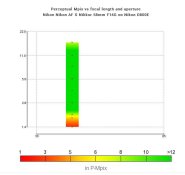specfically (i.e. reduced/eliminated coma and flare).
More than "reduced flare" it has less "sagital coma flare", so less coma.
This refinent is probably obtained from the two aespheric elements included, as coma is an effect from spheric aberration, and aespheric surfaces when included usually correct better spheric aberration.
Of course, you will notice that coma abscence mostly in the corners, if you have bright points there, and only when shooting wide open (other lenses also avoid coma when the lens stopped), so this lens is ideal to shot wide open at night if avoiding coma is wanted. Beyond that particular situation you won't get much a substantial benefit compared to the 50mm f/1.4G.
Surprisingly to me, this 50mm lens has remarkable barrel distorion, that can be corrected by the digital camera itself or in post, but that distortion is not nice for film. It was surprising to me because this lens has 9 elements, and that high element count (for a 50mm range "unit focus" prime) may allow to correct well distorion, but it looks the design has other priorities.
A bit like the 50mm f/1.4 AFD vs 50mm f/1.8 AFD, the cheaper 1.8D has lower distortion than the more expensive 1.4D and the 1.8D is slightly sharper, but the 1.4D avoids focus breathing, which the 1.8 has from its "unit focus" comfiguration.
Interestingly the 58mm f/1.4 is also a "unit focus" lens like the 50mm f/1.8AFD, this means that image grows when you focus closer, in theory this is a flaw for shooting videos as when you move focus from an actor to another one then the image magnification varies, delivering what usually is an undesired effect. Anyway "unit focus" usually contributes to good performance, for example the cheap 1.8 AFD has very good performance combined with low distortion in a low element count lens thanks to the "unit focus" configuration, not having to spend resources for the "internal focusing" configuration.
As the 58mm is unit focus, and not correcting much distortion, we can say that the 9 elements in the design are intensively devoted to remove coma in the large apertures, as the high priority of this design.
About the 58mm sunstars, diafragm is very circular not delivering much sunstars effect in the bright points. So all that money is mostly to conserve bright points without coma in the corners when shooting wide open.
Well, this is an expensive glass to get a modern emulation of the Noct Nikkor, for people wanting an expensive glass in the 50 range, with the benefit of delivering small bright points also in the corners, but "sporting" barrel distortion and focus breathing.
The regular 50mm 1.4G also delivers distortion, even more than the old 1.4AFD. Perhaps today correcting distorion is not a priority in the design, as electronics in the DSLR easily compensates that, and allowing some distortion then other factors can be better corrected.
IMO, beyond coma wide open, the 58mm 1.4G is not much better or worse than the 50mm 1.4G, but it's quite more expensive.


 .
.
 .
. .
.